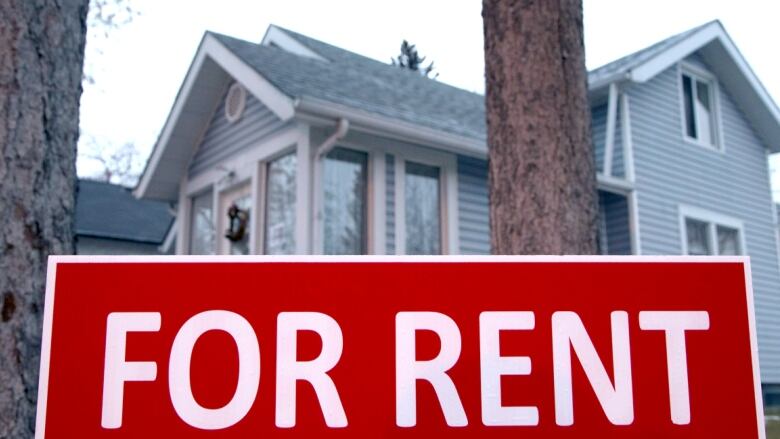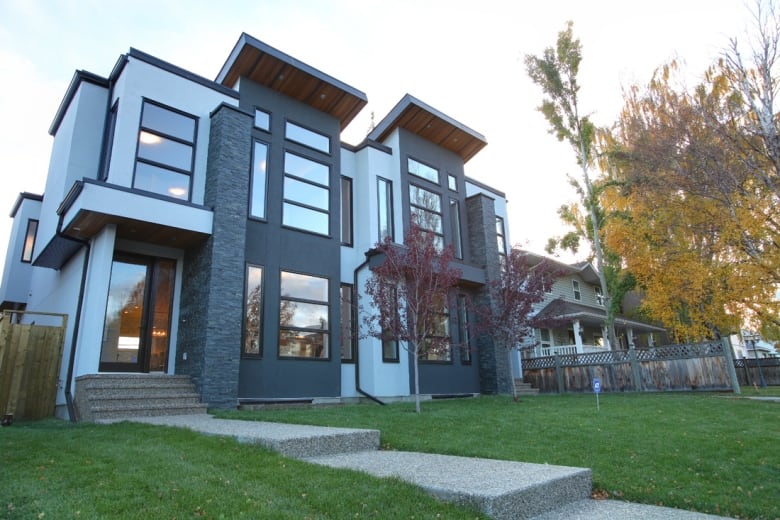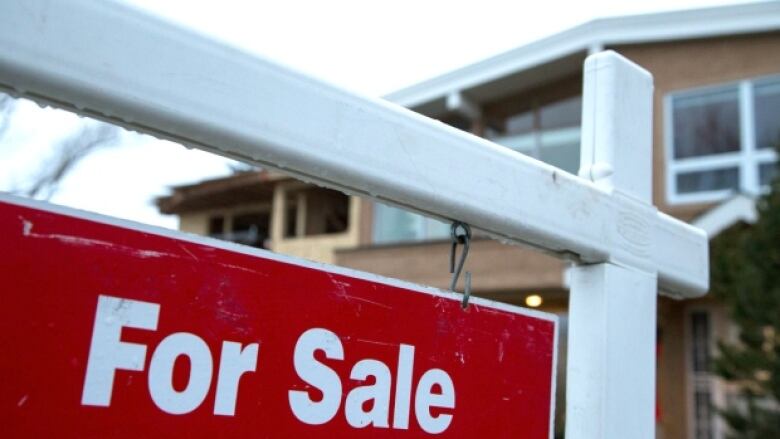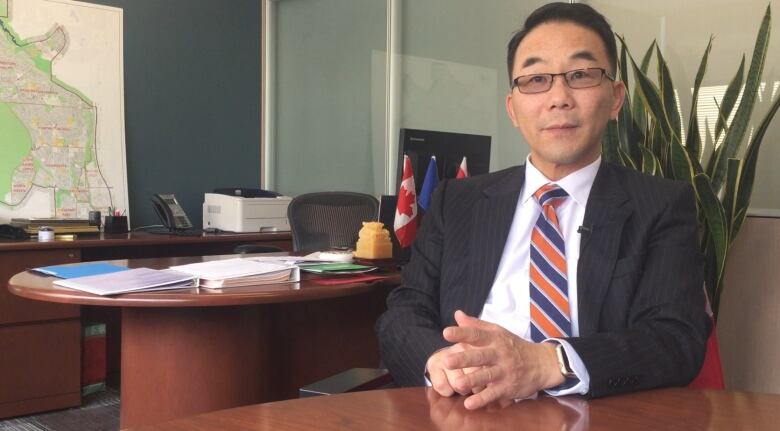Now why would they go and build that there? How house design can drive neighbours nuts
From infills to secondary suites to renters moving onto the block, we have no shortage of tension in this city

This article was originally published on May 20, 2018.
Calgarians have a lot of complicated feelings bound up with our notions of dwellings. Some of these extend from our self-mythologizing about the Alberta way; others contradict it entirely.
Who lives where and how is a fraught concept, at once simple and complex, fundamental and frivolous, nobody else's business yet irretrievably tangled in our social framework.
It touches on divisive issues, some of which we'd rather not talk about. It informs our sense of ourselves and of others. Housing and its adjacent questions are often among the third rails of our public discourse.
From secondary suites and alternative housing to infills and fear of change, we have no shortage of tension in our city around the questions of housing.
Those battles have been examined before, some of them to death. But what do the fights themselves tell us about our city? If where and how we live reflects our cultural, social and political sensibilities, what can we learn about Calgary from looking at the fault lines around homes, houses, and the idea of community?
Filling the city with infills
One of the earliest types of redevelopment in Calgary and therefore one of the earliest sources of conflict was infill housing.
Taking a lot in an inner-city neighbourhoodthat previously held a single-family detached home and building two new dwellings on it was an easy way to densify existing communities. As a bonus, the new houses often raised the property value of the surrounding area.
Win-win, right?
"Cities are about change," said John Brown, professor of architecture at the University of Calgary's Faculty of Environmental Design.
"Cities are about each generation reflecting itself and its culture through the city. Cities aren't static. The only cities that are static are dead. The fact that the inner-city communities in Calgary are rejuvenating is a wonderful thing. Are all of the designs great? No. But ...the older houses that are 50, 60, 70 years old, they're not particularly well-designed either."
In that last sentence lie the seeds of conflict.
Setting aside for now the question of increased density (don't worry, we'll return to it, it's inescapable), one main criticism of infill housing is that it sticks out like a sore thumb in established communities. The architecture is sleek and modern, and the design of the houses almost always makes them significantly taller than those from past generations.

This being Calgary, where genuine historical treasures rarely cause development to break stride, there's also the question of what we're tearing down. While Brown doesn't see much historical value in Calgary's old houses, others might disagree in some cases.
Take, for example, an inner-city neighbourhood like Sunalta, which has beautiful streets with rows of well-kept homes from the 1920s, 30s and 40s, many of which have been painted bright colours with white trim. These are enchanting streetscapes that give the neighbourhood a unique character.
Yet, there is nothing to stop a developer from buying a row of them up and tearing them down if they believe there's more profit to be had in another type of structure.
Max Foran, a professor emeritus at the University of Calgary who has extensively studied the development of Calgary's suburbs, points to the inherent neighbourhood tensions between the increase in property values that infills bring and the changing esthetic.
"This causes disharmony in the urban landscape," he said. "Some people don't like it; some people do."
Whether we as individuals see such development as a clear travesty or simple progress reflects our personal views on the politics of not only community or housing, but a host of issues such as free-market capitalism and the question of what constitutes historical value.

Many people might say the Sunalta houses represent such value, but the quagmire grows murkier when we look at other areas. Are those unremarkable bungalows from the 1960s valuable? What about the cookie-cutter, two-storey houses with vinyl siding and streetfront garages from the 1990s? Are these also worth preserving in the name of history? Or worth sacrificing in the name of density?
Other difficult questions abound: Are existing residents unreasonable for objecting to significant changes to their neighbourhood? If the opposition is not on the grounds of redevelopment but inappropriate esthetics, is that NIMBYism?
"It's a discussion about what the good life is," saidBrown. "And every house that's built is a reflection of the good life at the time it was built."
While he'll allow for the possibility of preservation in "exceptional circumstances where there's a building that's been designed thoughtfully," in general Brown frames the issue as one of simple progress.
"This is really a conversation about a sense of culture, and about history, and the relationship of history to culture. It gets twisted into an argument about consumerism and trophy houses and all of that, when in fact, the conversation that's really happening is about continuity versus change."
Those damn renters
Another Calgary housing battleground isn't about what gets built or torn down, but rather who owns it.
Once upon a time, people saw homes as a place to live. Now they're significant financial instruments, representing investment, risk, and profit. This is neither new nor unique to Calgary, but using homes to make money is a prominent approach here.
"Housing in Western Canada, and particularly in Calgary, is associated with property ownership," saidForan. "And that is very different from Europe, or even a lot of eastern Canada."

The social pressure to buy a home comes from several places. Family and friends might tell us it's the right thing to do. Our culture promotes the idea that the ideal (if not the only) way to raise a family is in a single-family detatched dwelling.
But the financial imperatives around the issue have contributed to something of a cult of home ownership. Not only is buying a home said to be a sound investment (and in many cases, it may well be), but it is also a wiser use of your housing dollar than renting.
Why throw money away every month to pay someone else's mortgage when you could be contributing towards your own?
Of course, buying property may be a smart move for many people, depending on several factors, and we need not explore renting versus buying here. (The CBC's Robson Fletcher previously examined that question, as well as the public response.)
- ANALYSIS |Why young people who can afford it are choosing not to buy homes in Calgary
- READER FEEDBACK | Rent or Buy The Great Calgary Debate: Here's what you had to say
It's undeniable that we, as a society, have a hard time with the idea that not buying a house is the right call for many people, even if they can afford to.
But the rent-or-own debate has another side, one that has less to do with home ownership and more with stereotypes of who rents.
One recent example came on Jan. 29, during a city council discussion of the results of the Calgary's citizen satisfaction survey. Speaking of the demographic breakdowns in the numbers among groups such as millennials and boomers and questioning the usefulness of those categories Ward 13 Coun. Diane Colley-Urquhart asked a pollster, "How many millennials that you talked to pay taxes?"

When told that information wasn't available, she observed, "It's great to say you want all these things, and if you're not paying taxes, you want the world." Her Ward 7 colleague Druh Farrell later pointed out,"They pay it through their rent, even if they don't get a property tax bill."
Perhaps the councillor meant nothing by her remarks, but many citizens saw an allusion to a familiar trope: the renter as a young, rowdy, lazy, troublesome, noisy, low-income, leeching pox on civil society.
This idea is not unique to Calgary. But it is a popular image in a city largely built in the American suburban model, where the most desirable (and most respectable) life was long defined as working hard to buy a house and car and settle down.
Jyoti Gondek who, prior to becoming the city councillor for Ward 3, was an urban sociology academic is familiar with this view.
"I've heard it very clearly at public hearings and public engagement processes," she said. "There's people who will flat-out say, 'Listen, I have money. I can afford to live here. And someone who can't shouldn't live here.' Then I've heard the very veiled, 'We're worried about the character of our neighbourhood.' Some people are quiet about it.Others really don't care."
But Gondek notes this stereotype is just one among many when it comes to housing.
"We like to have labels," she said."And our labels get us into a lot of trouble. We like to say urban vs. suburban, we like to say renter vs. owner, we like to say youth vs. senior, Canadian vs. new Canadian, all of these things. And we do that in an effort to categorize or compartmentalize people so that we can have an expectation of what our interactions with such a person would be like. But I think that leads to a lot of stereotyping, which gets us into trouble."
This "other-ing" of our fellow citizens is a common phenomenon in any human society, and counterproductive to finding a way forward that benefits the community and collective city. The worst-case scenario for any group is almost never emblematic of the whole.
Secondary suites and the density dilemma
Perhaps no single issue captures Calgary's housing hang-ups as comprehensively as secondary suites.
The long-simmering fight over who can add a suite to their property, and how onerous the process should be, was recently boiled down to a resolution of sorts: City council voted 9-6in favour of making secondary suite applications the domain of planning department staff and not elected officials.
In other words, after nearly two decades of heated political wrangling and public hand-wringing, we have finally caught up to the baseline of other major Canadian cities.
Folks will no longer come before council to plead their case for putting a stove in their basement so grandma can live with them. (For the record, the bylaw change does not promise "secondary suite strip clubs," one of the more imaginative fears referenced in letters submitted to councilby citizens opposed to the change.)
Aside from freeing up significant time for council to do the other things that councils need to do, the new process takes the politics out of secondary suite applications in favour of bureaucracy. Rather than having to publicly win over politicians mindful of answering to their constituents at election time, suite enthusiasts instead submit their plans to bureaucrats who evaluate established criteria and ensure regulations are being followed.
Just as before, the neighbourhood in question still has a voice in the process.
So what are we so afraid of?
"If we hand this to administration, they are going to approve everything, in my opinion," fretted Sean Chu, as he voted against the original motion in December. He also voted against the new bylaw change in March.

Meanwhile, Mayor Naheed Nenshi and other councillors have said that the previous council spent one-fifth of its time on secondary suite applications something that other major cities delegateto civil servants. The approval process alone represented a stubborn bonfire of public money. Add that to thesavings that come from providing public services to denser areas, and secondary suites make all kinds of financial sense for Calgary.
That raises the oft-asked question: Why do fiscally minded councillors fight against them?
The answer lies in the fears of the people who elect them.
Fear of change
Among the most commonly cited fears related to secondary suites are parking and traffic snarls, questionable people moving inand added density.
Density is a recurring fear for many Calgarians the idea that more people equals more hassle, more problems, more noise.
"I think that people are naturally suspicious of anything that happens in their neighbourhood," said Foran.
Many fears and suspicions are rooted in a lack of information.
For example, renters are less likely than homeowners to own a vehicle. Moreover, the higher the density, the less need for everyone to own a car, as transit service increases and more businesses cater to the area.
These amenities can provide residents with a better quality of life and make the area more desirable, perhapsincreasing property values.
Gondeksays that lack of understanding affects more than one side of housing issues, and extends to how we perceive each other.
"I think what's happeningis change is impacting those very people who are so resistant to it," she said."I think a lot of times, people in a certain segment of the population often get a bad name."
My house is who I am
She notes that many of those residents in established areas are older and the unexpected evolution of their community is just one of several changes they may be grappling with.
"Who you used to be is no longer who you are, and therefore your life changes," she said.
"And when you start losing that comfort and sense of self, everything else becomes somewhat threatening. The prospect of new and different people with different ways of life moving into your neighbourhood and possibly monkeying around with your sense of certainty becomes overwhelming."

A2015 poll by Ipsos found a significant majority of respondants in all quadrants of Calgary 73 per cent across the city supported more development of secondary suites. Renters were more likely than homeowners to be supportive.
While Foran agrees with Gondek's assertion that delineations of age and class can be overused, he acknowledges that the battles around housing often have that colouring "up to a point."
Brown, however, believes all debates over housing come down to self-interest.
"I don't think we care about how other people live, except in how it affects us."
The notion of home
Calgary is, of course, not unique in its housing quandries, though its particular blend of flat, cheap land, high population growth and decades of high wages, coupled with changing demographics today, certainly impart a distinct flavour to the conversations.
"Housing is complex," said Brown, "because it touches on the most personal and intimate aspects of our lives: the notion of home. It's also the biggest financial investment that most people are ever going to make. And it's tied up with community and sense of self, and sense of other. ... So it's only natural that there are complex ideas about community and how people consider housing. It would be odd if they didn't."
While he admits it's not reasonable to expect many people to take an interest in the history of the subject, Foran believes there are lessons to be learned from Calgary's development past that might change our conversation about the future.
Housing is complex, because it touches on the most personal and intimate aspects of our lives: the notion of home.-John Brown
"I look back on our freewheeling society where ... the interactions between what we did were not understood. Now we do understand ... the importance of the environmental, social, cultural interactions. We look at everything," he said.
"While I agree that it would be good if you knew about the city's development, that means changing the belief system. Belief systems look forward, not back."
For Gondek, how we talk about these thingsis just as important as what we talk about.
"I don't think we have sociological conversations at all. We don't look at the intersection of people and place. We get extremely focused on the built form," she said.
"We tend to focus a lot on integrating newcomers, but I think we've got to make sure we reach out to existing communities and say, 'Listen, your community is going to change over time. Let's talk about what that might look like and what the benefit is for you.'"
If there's one thing all three experts can agree on, it's that the conversations around housing are far from over.
"Change is going to take place," saidForan. "It's [a question of] what sort of change. People are mostly affected by the bottom line: What's it going to cost me? Do we want to pay for the sorts of sacrifices we're going to have to make to have a better city? I'm not sure."
Calgary: The Road Aheadis CBC Calgary's special focus on our city as it passes through the crucible of the downturn: the challenges we face, and the possible solutions as we explore what kind of Calgary we want to create.Have an idea? Email us at calgarytheroadahead@cbc.ca













_(720p).jpg)


 OFFICIAL HD MUSIC VIDEO.jpg)
.jpg)



























































































